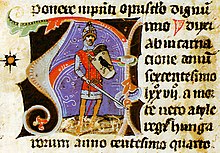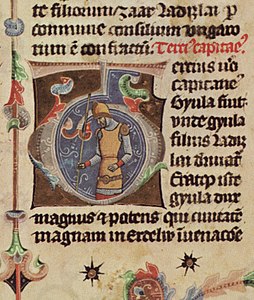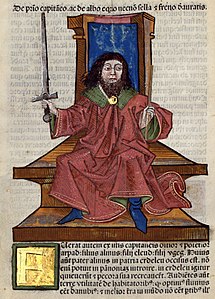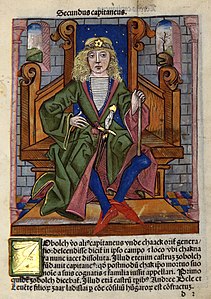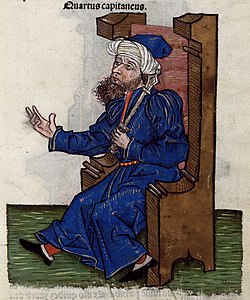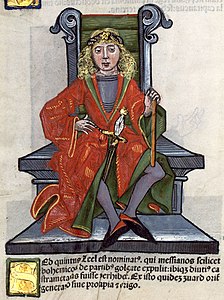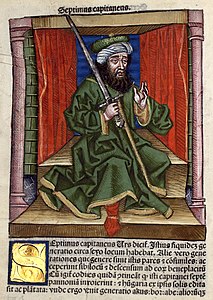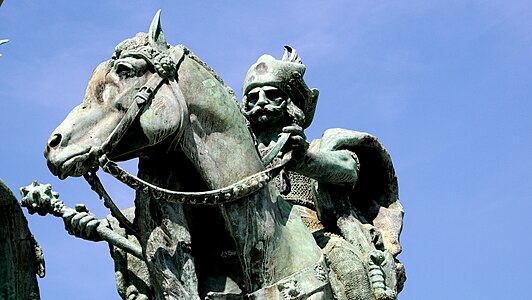
Árpád was the head of the confederation of the Magyar tribes at the turn of the 9th and 10th centuries. He might have been either the sacred ruler or kende of the Hungarians, or their military leader or gyula, although most details of his life are debated by historians, because different sources contain contradictory information. Despite this, many Hungarians refer to him as the "founder of our country", and Árpád's preeminent role in the Hungarian conquest of the Carpathian Basin has been emphasized by some later chronicles. The dynasty descending from Árpád ruled the Kingdom of Hungary until 1301.

The Turul is a mythological bird of prey, mostly depicted as a falcon, in Hungarian tradition and Turkic tradition, and a national symbol of Hungarians.
The Árpád dynasty consisted of the members of the royal House of Árpád, also known as Árpáds. They were the ruling dynasty of the Principality of Hungary in the 9th and 10th centuries and of the Kingdom of Hungary from 1000 to 1301. The dynasty was named after the Hungarian Grand Prince Árpád who was the head of the Hungarian tribal federation during the conquest of the Carpathian Basin, c. 895. Previously, it was referred to as the Turul dynasty or kindred.
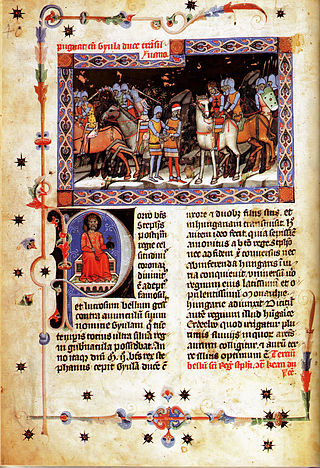
Gyula was, according to Muslim and Byzantine sources, the title of one of the leaders, the second in rank, of the Hungarian tribal federation in the 9th–10th centuries. In the earliest Hungarian sources, the title name is only recorded as a personal name.
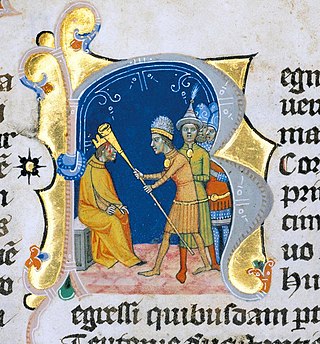
Lehel, a member of the Árpád dynasty, was a Magyar chieftain and, together with Bulcsú, one of the most important figures of the Hungarian invasions of Europe. After the Magyar defeat at the Battle of Lechfeld, he was executed in Regensburg.

The Chronicon Pictum or Illuminated Chronicle is a medieval illustrated chronicle from the Kingdom of Hungary from the 14th century. It represents the artistic style of the royal court of King Louis I of Hungary. The codex is a unique source of art, medieval and cultural history.

Emese was the daughter of Duke Eunedubelianus of Dentumoger, the consort of the noblest Scythian prince Ügyek, and the mother of High Prince Álmos in Hungarian historical mythology; thus, she was the ancestress of the Hungarian royal house of Árpád, the dynasty which founded the Hungarian Kingdom. Due to a lack of reliable source material, it is difficult to separate the legends concerning Emese from her actual role as an historical person.

Hősök tere is one of the major squares in Budapest, Hungary, noted for its iconic Millennium Monument with statues featuring the Seven chieftains of the Magyars and other important Hungarian national leaders, as well as the Memorial Stone of Heroes, often erroneously referred as the Tomb of the Unknown Soldier. The square lies at the outbound end of Andrássy Avenue next to City Park (Városliget). It hosts the Museum of Fine Arts and the Palace of Art (Műcsarnok). The square has played an important part in contemporary Hungarian history and has been a host to many political events, such as the reburial of Imre Nagy in 1989. Most sculptures were made by sculptor György Zala from Lendva, with one made by György Vastagh.

In Hungarian mythology, Prince Csaba was the youngest son of Attila, King of the Huns. A fierce and skilled warrior, he led the Huns to victory in all the battles they encountered over the ages. He is the legendary leader of the Székelys.

The Magyar or Hungarian tribes or Hungarian clans were the fundamental political units within whose framework the Hungarians (Magyars) lived, before the Hungarian conquest of the Carpathian Basin and the subsequent establishment of the Principality of Hungary.

Ügyek, also known as Ugek or Ugec, was – according to the chronicler Anonymus – the father of Álmos, the first Grand Prince of the Hungarians. However, according to a conflicting source, Simon of Kéza, Előd was the father of Álmos, while the chronicler referred to Ügyek as Álmos's grandfather. He is the earliest known ancestor of the Árpád dynasty. He was said to be a Scythian, i.e. to be from Dentumoger, the homeland of the Magyars, which the chroniclers identify with Scythia, and use to refer both to the land and its inhabitants.
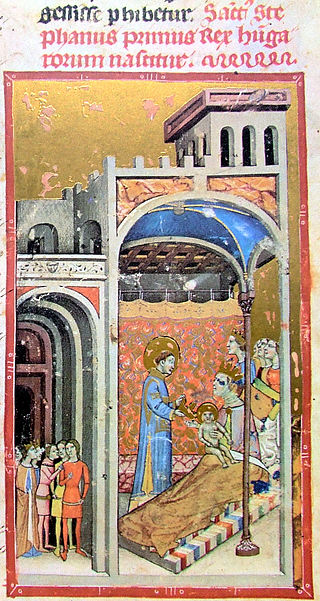
Sarolt was the wife of Géza, Grand Prince of the Hungarians.
Gyula III, also Iula or Gyula the Younger, Geula or Gyla, was an early medieval ruler in Transylvania. Around 1003, he and his family were attacked, dispossessed and captured by King Stephen I of Hungary (1000/1001-1038). The name "Gyula" was also a title, the second highest rank in Hungarian tribal confederation.

Előd was – according to the chronicler Anonymus, author of the Gesta Hungarorum – one of the seven chieftains of the Magyars (Hungarians), who led them to the Carpathian Basin in 895.

Honfoglalás is a 1996 Hungarian film about the Magyar settlement in Hungary in approximately AD 896.

The blood oath was, according to tradition, a pact among the leaders of the seven Hungarian tribes, traditionally held to be the first, unwritten constitution of the Hungarian nation. Its story, along with the terms agreed upon in it, is mostly known from the somewhat unreliable Gesta Hungarorum, a chronicle written between 1196–1203 and is thus possibly influenced by 12th century laws and customs. The oath was sealed by the seven leaders – Álmos, Előd, Ond, Kond, Tas, Huba and Töhötöm – by cutting their arms and letting their blood into a chalice. Becoming blood brothers is likely to have been used traditionally to seal exceptionally strong oaths, and there must have been several similar oaths, but the phrase "blood oath" usually refers to the one by the seven leaders.

Bulcsú was a Hungarian chieftain and military leader in the 10th century. He held the title of harka. Despite he was not a member of the ruling Árpád dynasty, he was one of the most important figures of the Hungarian invasions of Europe. He led military campaigns in directions to the north, west and east either in the period 930–950s.

Álmos, also Almos or Almus, was—according to the uniform account of Hungarian chronicles—the first head of the "loose federation" of the Hungarian tribes from around 850. Whether he was the sacred ruler (kende) of the Hungarians or their military leader (gyula) is subject to scholarly debate. According to Constantine Porphyrogenitus, he accepted the Khazar khagan's suzerainty in the first decade of his reign, but the Hungarians acted independently of the Khazars from around 860. The 14th-century Illuminated Chronicle narrates that he was murdered in Transylvania at the beginning of the Hungarian conquest of the Carpathian Basin around 895.

